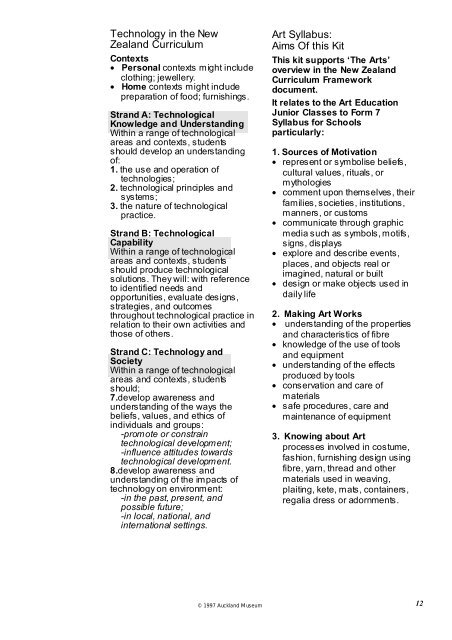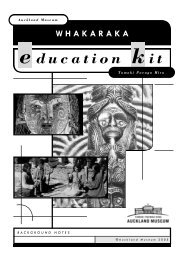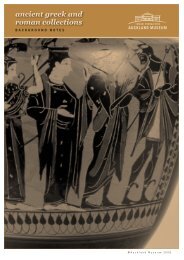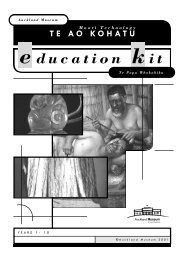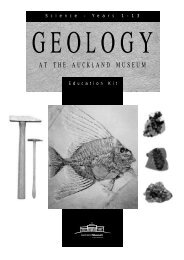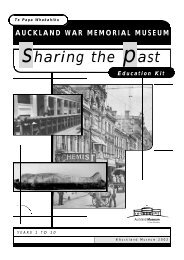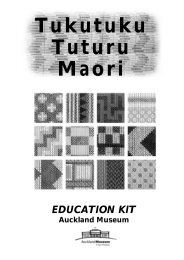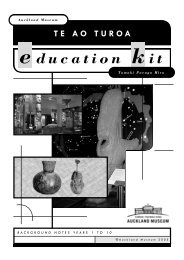Raranga Tuturu Maori - Auckland Museum
Raranga Tuturu Maori - Auckland Museum
Raranga Tuturu Maori - Auckland Museum
Create successful ePaper yourself
Turn your PDF publications into a flip-book with our unique Google optimized e-Paper software.
Technology in the New<br />
Zealand Curriculum<br />
Contexts<br />
• Personal contexts might include<br />
clothing; jewellery.<br />
• Home contexts might include<br />
preparation of food; furnishings.<br />
Strand A: Technological<br />
Knowledge and Understanding<br />
Within a range of technological<br />
areas and contexts, students<br />
should develop an understanding<br />
of:<br />
1. the use and operation of<br />
technologies;<br />
2. technological principles and<br />
systems;<br />
3. the nature of technological<br />
practice.<br />
Strand B: Technological<br />
Capability<br />
Within a range of technological<br />
areas and contexts, students<br />
should produce technological<br />
solutions. They will: with reference<br />
to identified needs and<br />
opportunities, evaluate designs,<br />
strategies, and outcomes<br />
throughout technological practice in<br />
relation to their own activities and<br />
those of others.<br />
Strand C: Technology and<br />
Society<br />
Within a range of technological<br />
areas and contexts, students<br />
should;<br />
7.develop awareness and<br />
understanding of the ways the<br />
beliefs, values, and ethics of<br />
individuals and groups:<br />
-promote or constrain<br />
technological development;<br />
-influence attitudes towards<br />
technological development.<br />
8.develop awareness and<br />
understanding of the impacts of<br />
technology on environment:<br />
-in the past, present, and<br />
possible future;<br />
-in local, national, and<br />
international settings.<br />
© 1997 <strong>Auckland</strong> <strong>Museum</strong><br />
Art Syllabus:<br />
Aims Of this Kit<br />
This kit supports ‘The Arts’<br />
overview in the New Zealand<br />
Curriculum Framework<br />
document.<br />
It relates to the Art Education<br />
Junior Classes to Form 7<br />
Syllabus for Schools<br />
particularly:<br />
1. Sources of Motivation<br />
• represent or symbolise beliefs,<br />
cultural values, rituals, or<br />
mythologies<br />
• comment upon themselves, their<br />
families, societies, institutions,<br />
manners, or customs<br />
• communicate through graphic<br />
media such as symbols, motifs,<br />
signs, displays<br />
• explore and describe events,<br />
places, and objects real or<br />
imagined, natural or built<br />
• design or make objects used in<br />
daily life<br />
2. Making Art Works<br />
• understanding of the properties<br />
and characteristics of fibre<br />
• knowledge of the use of tools<br />
and equipment<br />
• understanding of the effects<br />
produced by tools<br />
• conservation and care of<br />
materials<br />
• safe procedures, care and<br />
maintenance of equipment<br />
3. Knowing about Art<br />
processes involved in costume,<br />
fashion, furnishing design using<br />
fibre, yarn, thread and other<br />
materials used in weaving,<br />
plaiting, kete, mats, containers,<br />
regalia dress or adornments.<br />
12


